You Made It Around the Sun Again
Solar system planets, order and germination: A guide
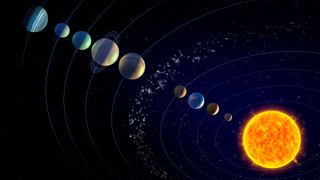
The social club of the planets in the solar system, starting nearest the dominicus and working outward is the following: Mercury, Venus, Earth, Mars, Jupiter, Saturn, Uranus, Neptune and and so the possible Planet Nine.
The solar system is made up of the sun and everything that orbits around it, including planets, moons, asteroids, comets and meteoroids.
The solar organization extends from the sun, called Sol past the ancient Romans, and goes past the four inner planets, through the asteroid belt to the four gas giants and on to the disk-shaped Kuiper Chugalug and far beyond to the teardrop-shaped heliopause. Scientists estimate that the edge of the solar system is about ix billion miles (15 billion kilometers) from the sun. Beyond the heliopause lies the giant, spherical Oort Cloud, which is idea to surround the solar organisation.
Related: Sounds in space: What noises practise planets brand?
Always since the discovery of Pluto in 1930, kids grew up learning that the solar system has nine planets. That all changed in the late 1990s when astronomers started arguing about whether Pluto was indeed a planet. In a highly controversial conclusion, the International Astronomical Union ultimately decided in 2006 to designate Pluto as a "dwarf planet," reducing the list of the solar system'south true planets to but eight.
If you insist on including Pluto, it would come subsequently Neptune on the list. Pluto is truly way out in that location and on a wildly tilted, elliptical orbit (2 of the several reasons it was demoted).
Astronomers, however, are still hunting for some other possible planet in our solar system, a true ninth planet, subsequently mathematical evidence of its beingness was revealed on January. 20, 2016. The alleged "Planet Ix," also chosen "Planet X," is believed to be about 10 times the mass of Earth and 5,000 times the mass of Pluto.
Related: 15 places on Earth that look exoplanetary
Types of planets in the solar system
The inner four planets closest to the sun — Mercury, Venus, Globe and Mars — are ofttimes called the "terrestrial planets" because their surfaces are rocky. Pluto also has a rocky, admitting frozen, surface but has never been grouped with the 4 terrestrials.
The iv large outer worlds — Jupiter, Saturn, Uranus and Neptune — are sometimes called the Jovian or "Jupiter-like" planets because of their enormous size relative to the terrestrial planets. They're also generally made of gases similar hydrogen, helium and ammonia rather than of rocky surfaces, although astronomers believe some or all of them may have solid cores.
Guild of the planets by size (smallest to largest)
If you were to lodge the planets past size from smallest to largest they would be Mercury, Mars, Venus, Earth, Neptune, Uranus, Saturn and Jupiter.
Jupiter and Saturn are sometimes called the gas giants, whereas the more than afar Uranus and Neptune have been nicknamed the ice giants. This is because Uranus and Neptune have more atmospheric water and other water ice-forming molecules, such equally methane, hydrogen sulfide and phosphene, that crystallize into clouds in the planets' frigid weather, co-ordinate to the Planetary Guild. For perspective, methane crystallizes at minus 296 Fahrenheit (minus 183 degrees Celsius), according to the U.S. National Library of Medicine.
What is (and isn't) a planet?
The IAU defines a true planet as a trunk that circles the dominicus without existence some other object's satellite; is big enough to be rounded by its own gravity (but non and so large that it begins to undergo nuclear fusion, like a star); and has "cleared its neighborhood" of most other orbiting bodies.
Only that restrictive definition helped isolate what should and should not be considered a planet — a problem that arose as astronomers discovered more than and more planet-like objects in the solar organization. Pluto was amongst the bodies that didn't make the cut and was re-classified equally a dwarf planet.
The problem with Pluto, aside from its small size and offbeat orbit, is that it doesn't articulate its neighborhood of debris — it shares its space with lots of other objects in the Kuiper Belt. Still, the demotion of Pluto remains controversial.
The IAU planet definition besides put other pocket-sized, round worlds into the dwarf planet category, including the Kuiper Belt objects Eris, Haumea and Makemake.
Ceres, a circular object in the Asteroid Belt betwixt Mars and Jupiter, besides got the boot. Ceres was considered a planet when it was discovered in 1801, but information technology was later accounted to be an asteroid. That still didn't quite fit considering it was and then much larger (and rounder) than the other asteroids. Astronomers instead deemed it a dwarf planet in 2006, although some astronomers like to consider Ceres every bit a 10th planet (not to exist confused with Nibiru or Planet X).
Below is a brief overview of the eight true planets in our solar system, moving from that closest to the dominicus to farthest from the sun:
The sun
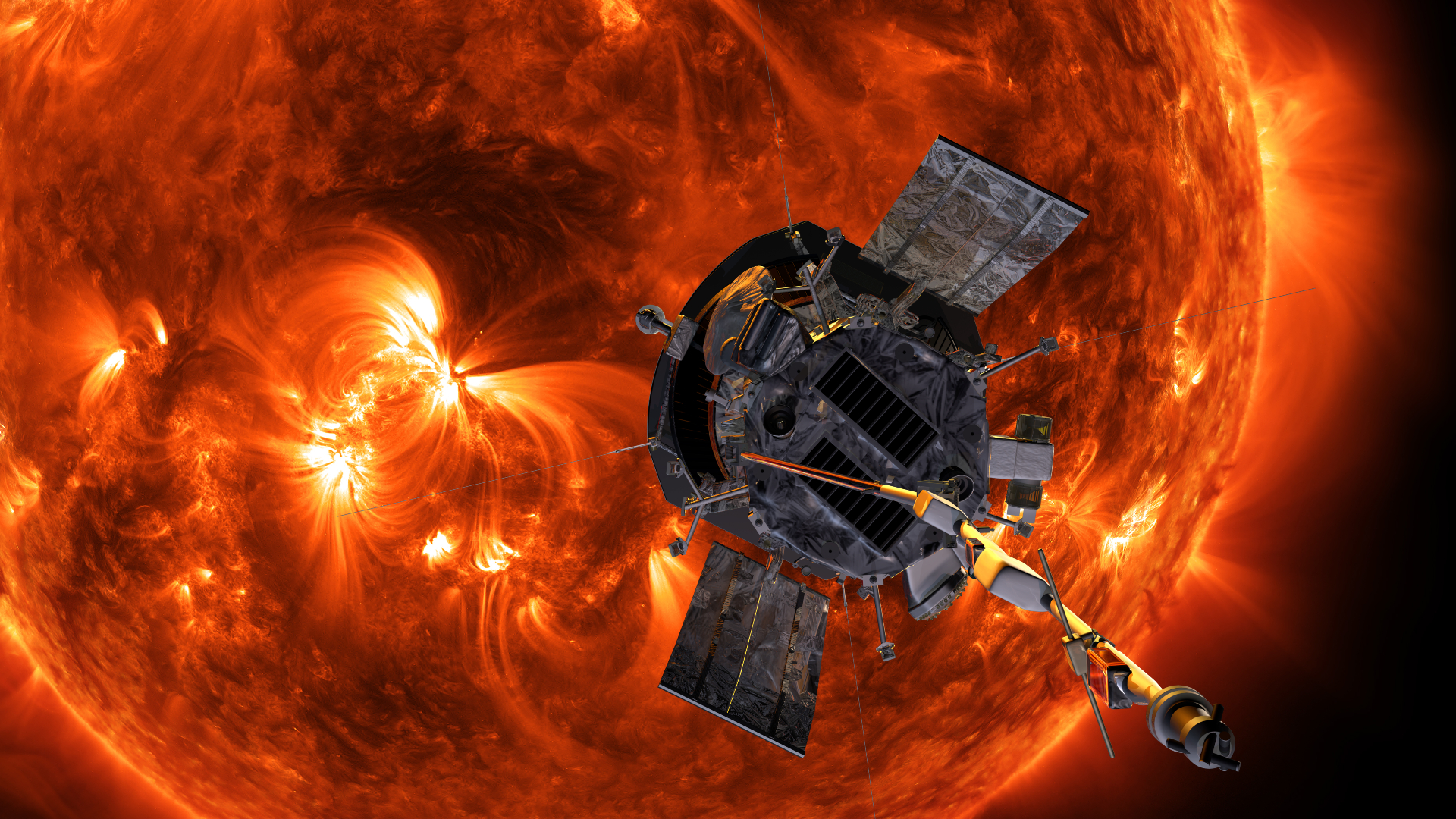
The sun is past far the largest object in our solar system, containing 99.8% of the solar system's mass. It sheds most of the heat and low-cal that makes life possible on Earth and possibly elsewhere. Planets orbit the dominicus in oval-shaped paths chosen ellipses, with the dominicus slightly off-center of each ellipse.
NASA has a fleet of spacecraft observing the sun, such equally the Parker Solar Probe, to learn more about its composition, and to make better predictions about solar activity and its effect on Globe.
Mercury: The closest planet to the sun
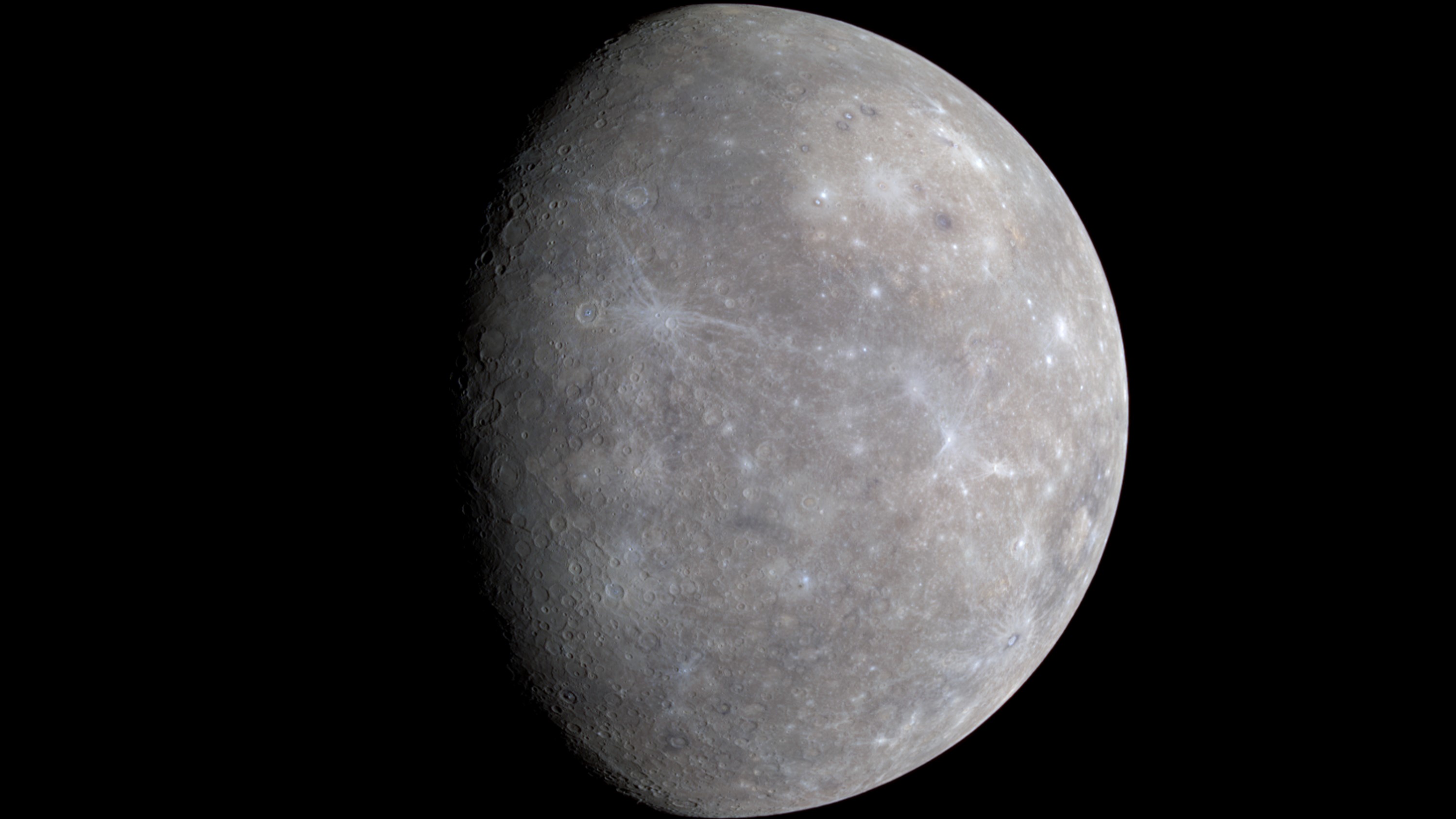
Mercury is the closest planet to the sun and the smallest planet in the solar system — information technology is just a little larger than Earth's moon. Mercury zips around the dominicus in but 88 days and because it is so shut to our star (near two-fifths the distance between Globe and the dominicus).
Mercury experiences dramatic changes in its day and night temperatures. Mercury temperatures can reach a scorching 840 F (450 C) in the day, which is hot enough to melt lead. Meanwhile, on the night side, temperatures drop to minus 290 F (minus 180 C).
Quick Mercury facts
- Discovery: Known to the ancient Greeks and visible to the naked eye
- Named for the messenger of the Roman gods
- Diameter: 3,031 miles (4,878 km)
- Orbit: 88 Earth days
- Day: 58.6 Earth days
- Number of moons: 0
Mercury's temper is very thin and primarily composed of oxygen, sodium, hydrogen, helium and potassium. Because the atmosphere is and so sparse it cannot incoming meteors, its surface is therefore pockmarked with craters, just like our moon.
Over its four-twelvemonth mission, NASA's MESSENGER spacecraft revealed incredible discoveries that challenged astronomers' expectations. Among those findings was the discovery of water ice and frozen organic compounds at Mercury's north pole and that volcanism played a major office in shaping the planet's surface.
Related: How was Mercury formed?
Venus: Earth'southward twin in the solar organization

Venus is the second planet from the sun and is the hottest planet in the solar system. Its thick atmosphere is extremely toxic and composed of sulfuric acrid clouds, the planet is an farthermost example of the greenhouse effect.
Quick Venus facts
- Discovery: Known to the ancient Greeks and visible to the naked middle
- Named for the Roman goddess of love and dazzler
- Diameter: seven,521 miles (12,104 km)
- Orbit: 225 Earth days
- Day: 241 Earth days
- Number of moons: 0
The average temperature on Venus' surface is 900 F (465 C). At 92 bar, the pressure at the surface would crush and kill you. And oddly, Venus spins slowly from east to west, the opposite management of most of the other planets.
Venus is sometimes referred to as Earth'south twin as they are like in size and radar images beneath its atmosphere reveal numerous mountains and volcanoes. But beyond that, the planets could not exist more different.
The Greeks believed Venus was two different objects — ane in the morning sky and some other in the evening. Because information technology is often brighter than any other object in the sky, Venus has generated many UFO reports.
Related: How was Venus formed?
Globe: Our home planet, filled with life
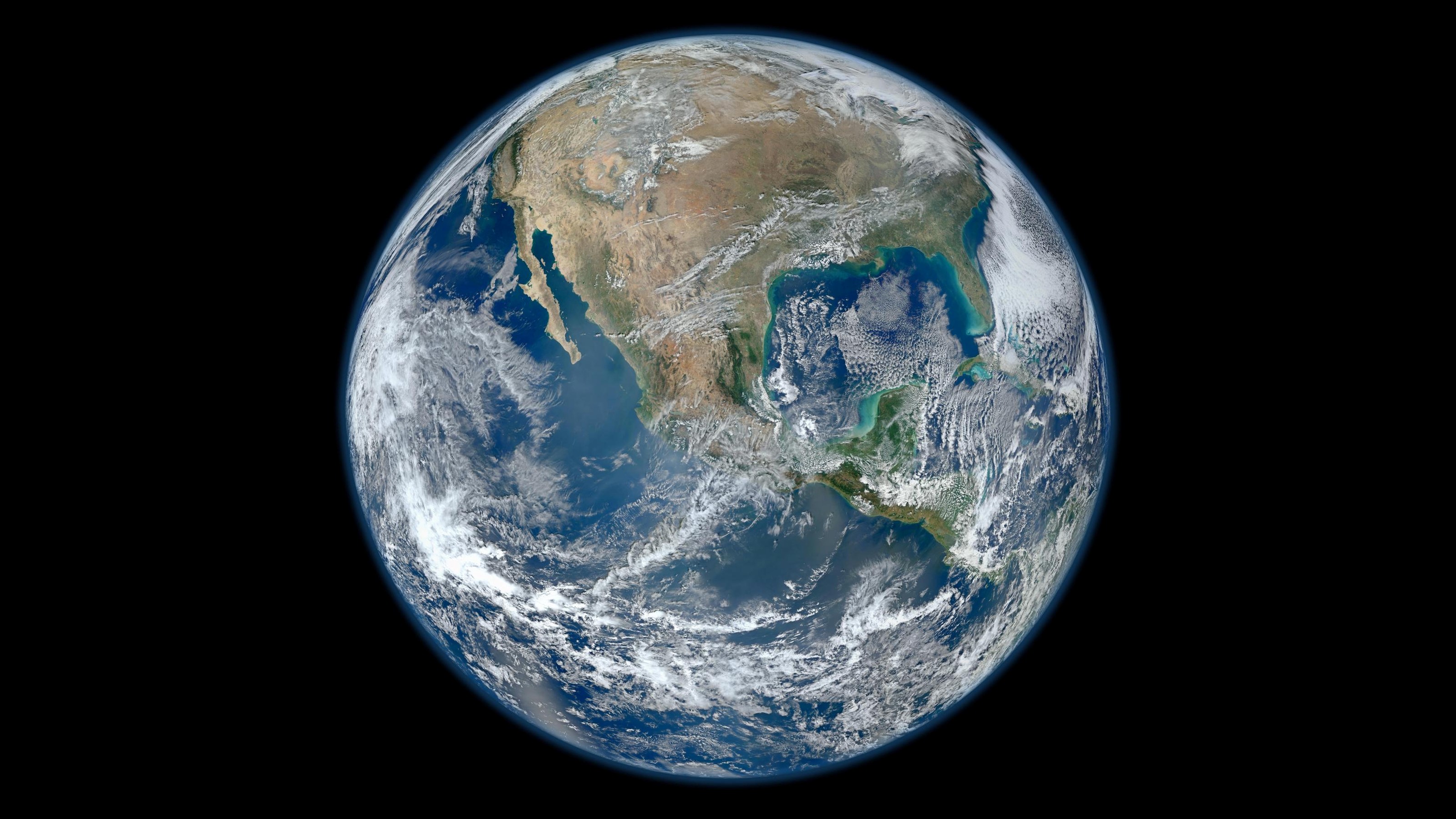
Earth, our home planet, is the third planet from the sun. It is a water earth with two-thirds of the planet covered past water. Earth'due south atmosphere is rich in nitrogen and oxygen and it is the only earth known to harbor life.
Quick Earth facts
- Name originates from "Die Erde," the German word for "the basis."
- Diameter: seven,926 miles (12,760 km)
- Orbit: 365.24 days
- Day: 23 hours, 56 minutes
- Number of moons: i
Earth rotates on its axis at 1,532 feet per 2nd (467 meters per second) — slightly more than one,000 mph (one,600 kph) — at the equator. The planet zips effectually the sun at more than than 18 miles per second (29 km per second).
Related: x Earth bear on craters you must see
Mars: The solar system's Scarlet Planet
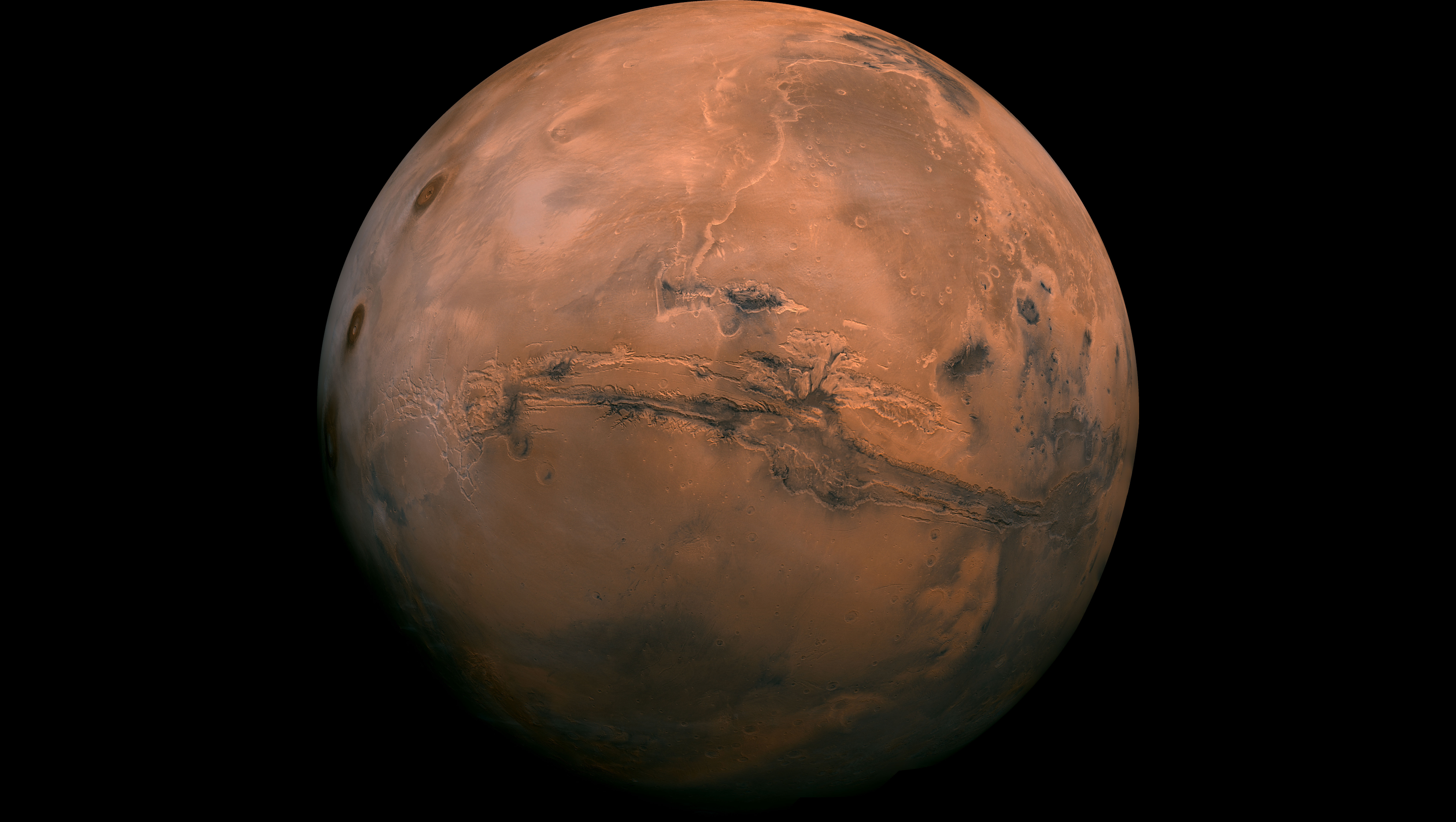
Mars is the fourth planet from the dominicus. It is a cold, desert-like planet covered in iron oxide dust that gives the planet its signature red hue. Mars shares similarities with Earth: Information technology is rocky, has mountains, valleys and canyons, and storm systems ranging from localized tornado-like dust devils to planet-engulfing dust storms.
Substantial scientific evidence suggests that Mars at one indicate billions of years ago was a much warmer, wetter earth, rivers and perchance even oceans existed. Although Mars' atmosphere is also thin for liquid water to exist on the surface for any length of fourth dimension, remnants of that wetter Mars still exist today. Sheets of water ice the size of California lie beneath Mars' surface, and at both poles are ice caps made in part of frozen water.
Quick Mars facts
- Discovery: Known to the ancient Greeks and visible to the naked eye
- Named for the Roman god of state of war
- Diameter: iv,217 miles (vi,787 km)
- 24-hour interval: Just more than 1 Earth day (24 hours, 37 minutes)
- Number of moons: 2
Scientists also think ancient Mars would have had the conditions to support life like bacteria and other microbes. Hope that signs of this past life — and the possibility of even current lifeforms — may exist on the Red Planet has driven numerous Mars missions and the Carmine Planet is now one of the near explored planets in the solar organisation.
Related: How long does it take to get to Mars?
The asteroid chugalug
Between Mars and Jupiter lies the asteroid belt. Asteroids are minor planets, and according to NASA in that location are approximately between ane.1 and ane.ix one thousand thousand asteroids in the main asteroid chugalug larger than 0.6 miles (ane km) in diameter and millions more smaller asteroids.
The dwarf planet Ceres, near 590 miles (950 km) in diameter, resides here. A number of asteroids have orbits that take them closer into the solar system that sometimes atomic number 82 them to collide with Earth or the other inner planets.
Jupiter: The largest planet in our solar organisation
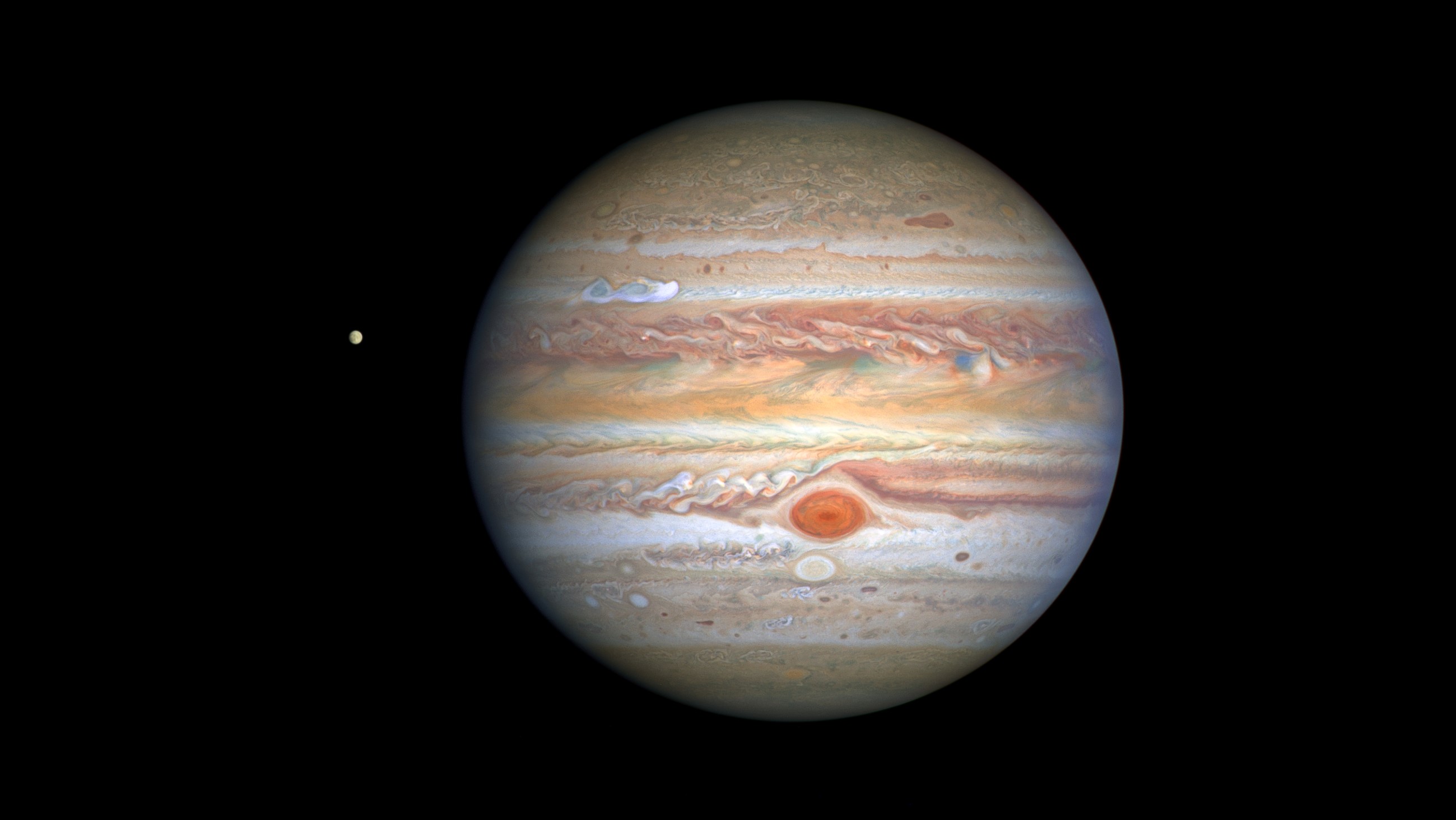
Jupiter is the 5th planet from the dominicus and the largest planet in the solar organisation. The gas behemothic is more than than twice equally massive every bit all the other planets combined, according to NASA.
Quick Jupiter facts
- Discovery: Known to the ancient Greeks and visible to the naked heart
- Named for the ruler of the Roman gods
- Bore: 86,881 miles (139,822 km)
- Orbit: 11.9 Earth years
- Day: 9.viii Earth hours
- Number of moons: 79 (53 confirmed, 26 provisional)
Its swirling clouds are colorful due to different types of trace gases including ammonia ice, ammonium hydrosulfide crystals as well as water ice and vapor.
A famous characteristic in its swirling clouds is Jupiter's Great Ruby Spot, a behemothic storm more than x,000 miles wide, kickoff observed in 1831 by apprentice astronomer Samuel Heinrich Schwabe. It has raged at more than 400 mph for the last 150 years, at to the lowest degree.
Jupiter has a strong magnetic field, and with 75 moons, including the largest moon in the solar system, Ganymede.
Related: Jupiter's moons: Facts near the largest Jovian moons
Saturn: The ringed jewel of the solar arrangement
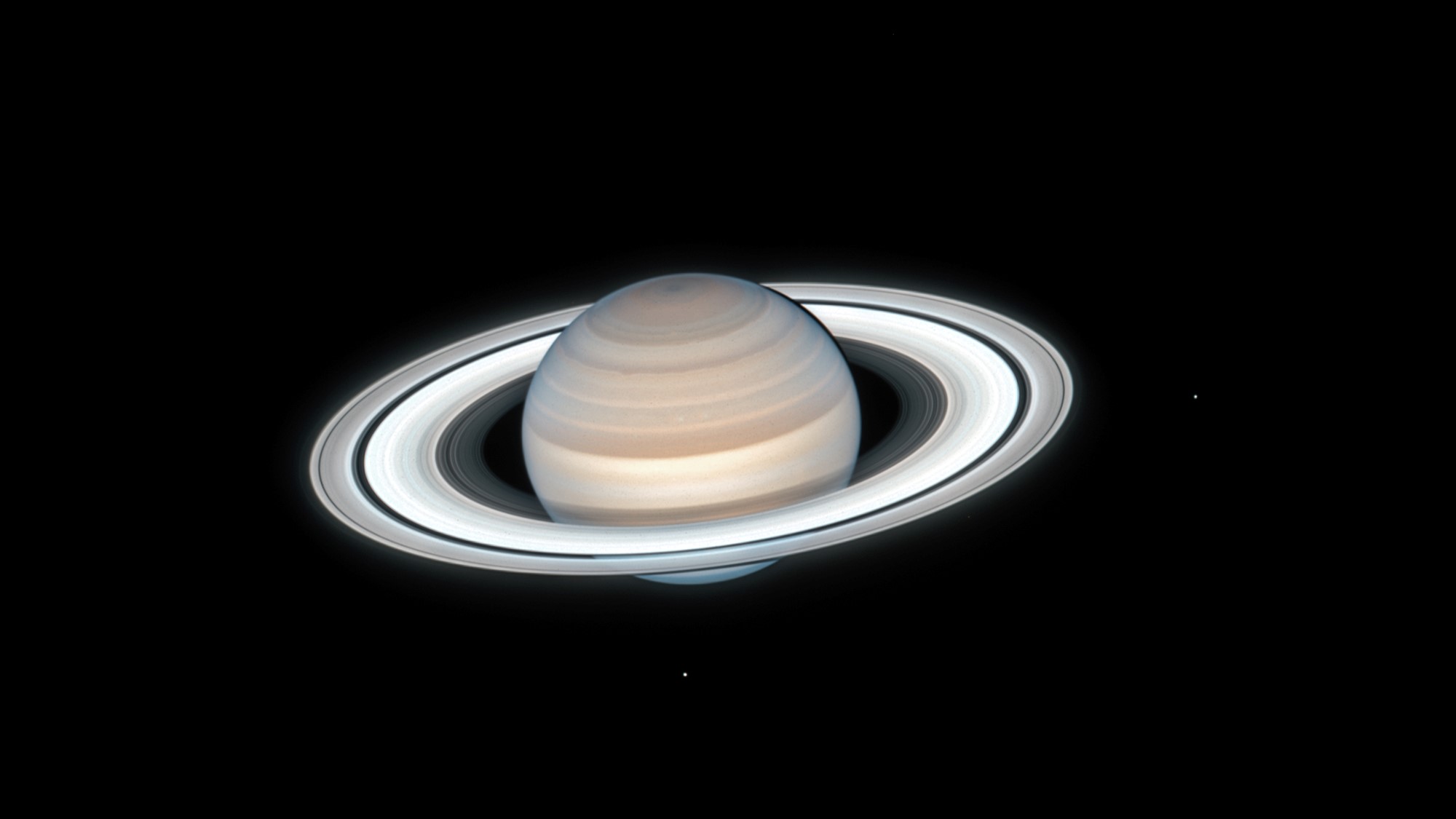
Saturn is the sixth planet from the dominicus and is famous for its big and distinct ring arrangement. Though Saturn is non the only planet in the solar system with rings.
Quick Saturn facts
- Discovery: Known to the ancient Greeks and visible to the naked eye
- Named for Roman god of agriculture
- Diameter: 74,900 miles (120,500 km)
- Orbit: 29.5 Earth years
- Day: Almost x.5 Earth hours
- Number of moons: 82 (53 confirmed, 29 provisional)
When polymath Galileo Galilei first studied Saturn in the early 1600s, he thought it was an object with three parts: a planet and two large moons on either side. Not knowing he was seeing a planet with rings, the stumped astronomer entered a pocket-sized drawing — a symbol with one large circle and two smaller ones — in his notebook, as a substantive in a sentence describing his discovery. More than forty years later, Christiaan Huygens proposed that they were rings.
Did you know?
If you put Saturn in a bathtub it would float as Saturn has an boilerplate density that is less than water. Y'all'd just demand to observe a bathtub big plenty…
The rings are made of ice and rock and scientists are non still sure how they formed. The gaseous planet is mostly hydrogen and helium and has numerous moons.
Related: How far abroad is Saturn?
Uranus: The tilted, sideways planet in our solar arrangement
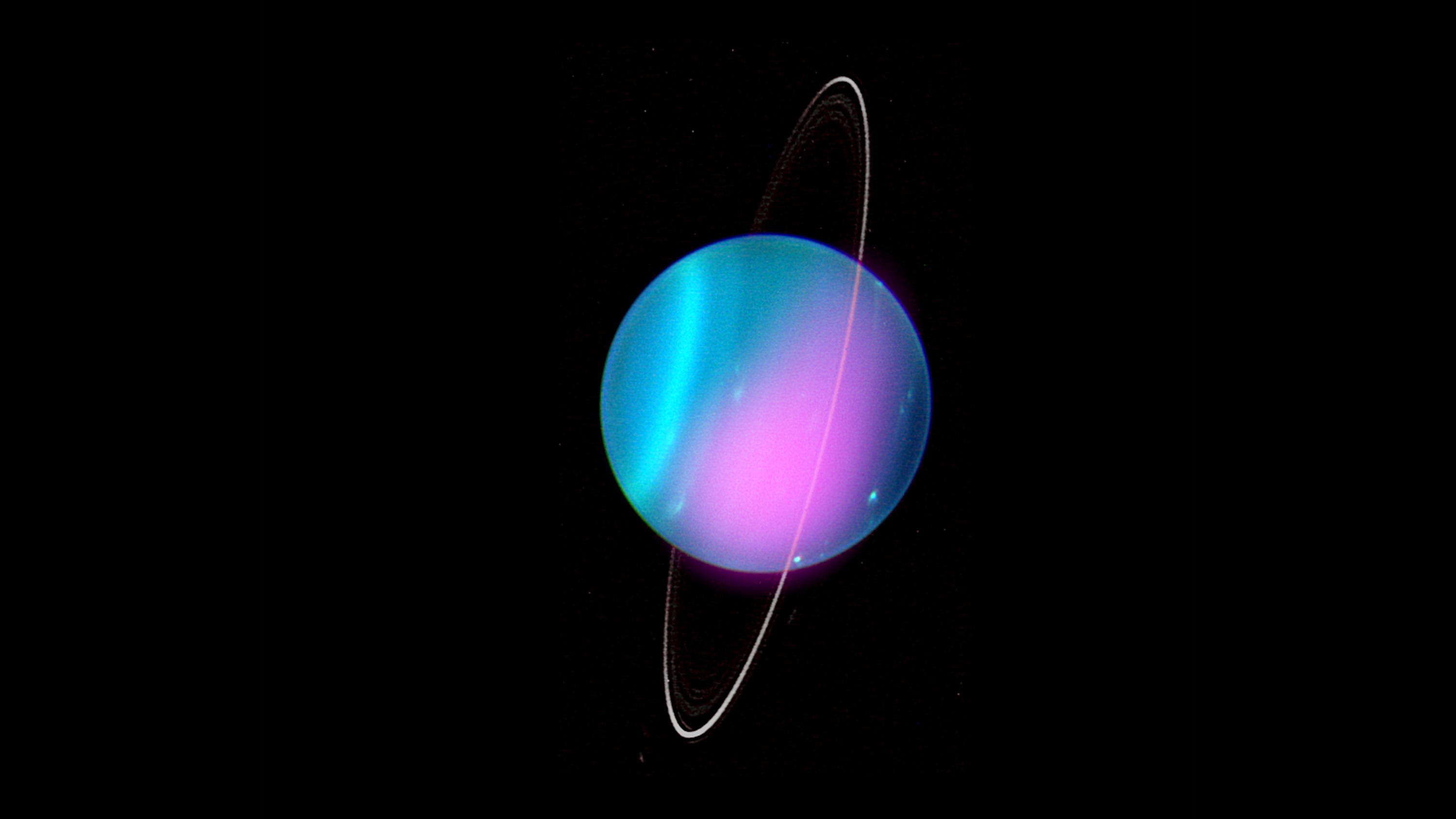
Uranus is the seventh planet from the sun and is a scrap of an oddball.
It has clouds made of hydrogen sulfide, the same chemical that makes rotten eggs smell and then foul. It rotates from east to west like Venus. Only dissimilar Venus or any other planet, its equator is nearly at right angles to its orbit — information technology basically orbits on its side.
Quick Uranus facts
- Discovery: 1781 by William Herschel (was originally thought to be a star)
- Named for the personification of sky in ancient myth
- Diameter: 31,763 miles (51,120 km)
- Orbit: 84 Globe years
- Day: xviii Earth hours
- Number of moons: 27
Astronomers believe an object twice the size of Earth collided with Uranus roughly 4 billion years ago, causing Uranus to tilt. That tilt causes extreme seasons that last 20-plus years, and the dominicus beats downward on 1 pole or the other for 84 World-years at a time.
The standoff is also thought to accept knocked rock and ice into Uranus' orbit. These later became some of the planet'southward 27 moons. Methyl hydride in Uranus' atmosphere gives the planet its bluish-green tint. It also has 13 sets of faint rings.
Uranus holds the record for the coldest temperature ever measured in the solar organisation — minus 371.56 degrees F (minus 224.2 degrees C). The average temperature of Uranus is minus 320 degrees Fahrenheit (-195 degrees Celsius).
Related: How did Uranus form?
Neptune: A giant, stormy blue planet
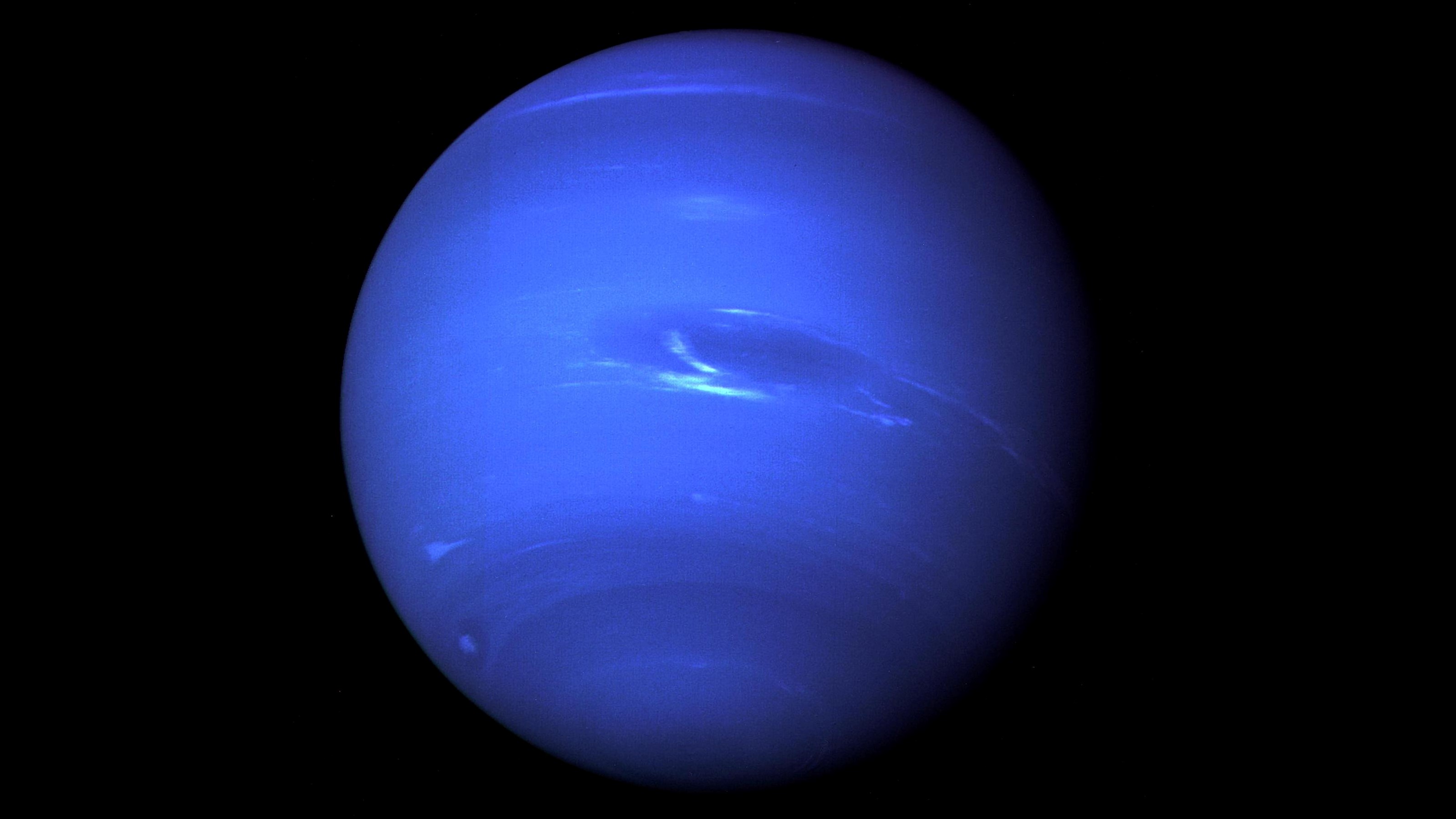
Neptune is the eighth planet from the lord's day and is on boilerplate the coldest planet in the solar system. The average temperature of Neptune at the top of the clouds is minus 346 degrees Fahrenheit (minus 210 degrees Celsius).
Quick Neptune facts
- Discovery: 1846
- Named for the Roman god of water
- Bore: 30,775 miles (49,530 km)
- Orbit: 165 World years
- Day: 19 Globe hours
- Number of moons: 14
Neptune is approximately the same size as Uranus and is known for its supersonic strong winds. The planet is more 30 times as far from the dominicus as Earth.
Neptune was the first planet predicted to exist past using math, rather than existence visually detected. Irregularities in the orbit of Uranus led French astronomer Alexis Bouvard to advise some other planet might be exerting a gravitational tug. German language astronomer Johann Galle used calculations to help find Neptune in a telescope. Neptune is about 17 times equally massive equally Earth and has a rocky core.
Related: There's something strange going on within Neptune
Trans-Neptunian region
Astronomers had long suspected that a band of icy material known equally the Kuiper Belt existed past the orbit of Neptune extending from about 30 to 55 times the distance of World to the sun, and from the last decade of the 20th century up to now, they have found more than than a k of such objects. Scientists estimate the Kuiper Chugalug is likely home to hundreds of thousands of icy bodies larger than 60 miles (100 km) broad, besides as an estimated trillion or more comets.
Pluto, at present considered a dwarf planet, dwells in the Kuiper Belt. Information technology is non lonely — recent additions include Makemake, Haumea and Eris. Another Kuiper Belt object dubbed Quaoar is probably massive enough to exist considered a dwarf planet, but it has not been classified every bit such still. Sedna, which is about three-fourths the size of Pluto, is the first dwarf planet discovered in the Oort Deject. NASA'due south New Horizons mission performed history'southward get-go flyby of the Pluto organization on July 14, 2015.
Pluto: One time a planet, now a dwarf planet
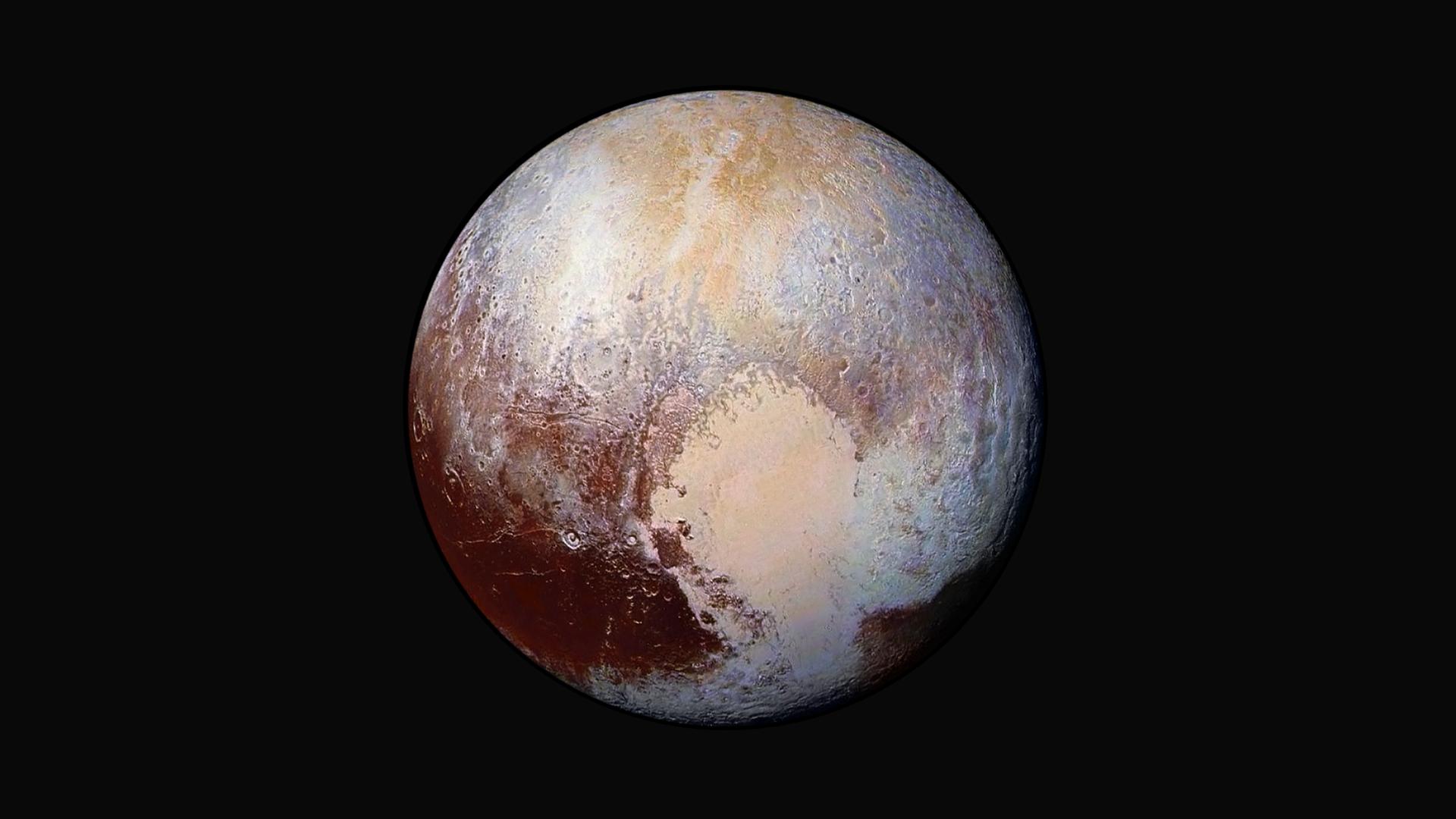
Pluto was once the 9th planet from the sunday and is unlike any other planet in the solar system.
Quick Pluto facts
- Discovery: 1930 by Clyde Tombaugh
- Named for the Roman god of the underworld, Hades
- Bore: 1,430 miles (two,301 km)
- Orbit: 248 Earth years
- Twenty-four hour period: 6.4 Globe days
- Number of moons: 5
It is smaller than Earth'southward moon; its orbit is highly elliptical, falling inside Neptune's orbit at some points and far across it at others; and Pluto'south orbit doesn't fall on the aforementioned plane as all the other planets — instead, it orbits 17.1 degrees above or beneath.
Information technology is smaller than Earth'southward moon; its orbit is highly elliptical, falling inside Neptune'south orbit at some points and far beyond it at others; and Pluto'south orbit doesn't fall on the same plane equally all the other planets — instead, it orbits 17.ane degrees above or beneath, taking 288 years to consummate a unmarried orbit co-ordinate to ESA.
From 1979 until early 1999, Pluto had been the 8th planet from the dominicus. Then, on Feb. 11, 1999, it crossed Neptune's path and one time again became the solar system'south most afar planet — until it was redefined equally a dwarf planet. It's a cold, rocky world with a tenuous atmosphere.
Scientists idea it might be nothing more than a hunk of rock on the outskirts of the solar organization. But when NASA'south New Horizons mission performed history'southward commencement flyby of the Pluto arrangement on July fourteen, 2015, it transformed scientists' view of Pluto.
Pluto is a very agile ice world that'due south covered in glaciers, mountains of ice water, icy dunes and possibly even cryovolcanoes that erupt icy lava made of h2o, methane or ammonia.
Related: Why isn't Pluto a planet anymore?
Planet Nine: A planet search at solar system's edge
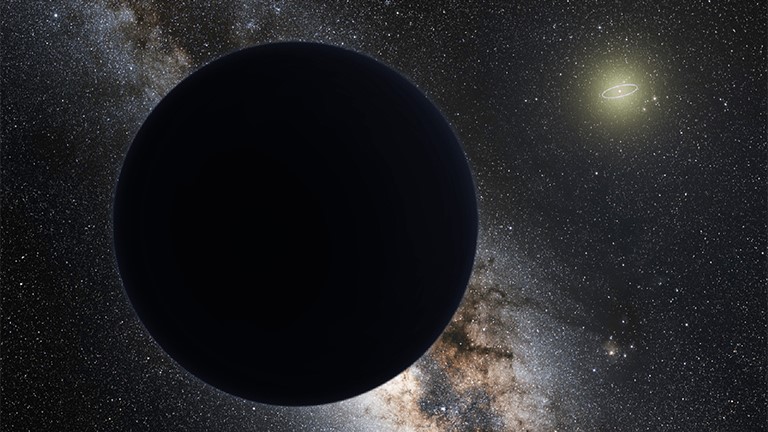
In 2016, researchers proposed the possible existence of a ninth planet, for now, dubbed "Planet Ix" or Planet X. The planet is estimated to be about 10 times the mass of World and to orbit the sun between 300 and 1,000 times further than the orbit of the World.
Scientists take not seen Planet Nine. They inferred its existence past its gravitational effects on other objects in the Kuiper Belt, a region at the fringe of the solar organization that is abode to icy rocks left over from the birth of the solar system. Also called trans-Neptunian objects, these Kuiper Belt objects accept highly elliptical or oval orbits that align in the same direction.
Scientists Mike Brown and Konstantin Batygin at the California Plant of Technology in Pasadena described the bear witness for Planet Ix in a study published in the Astronomical Journal. The research is based on mathematical models and computer simulations using observations of half-dozen other smaller Kuiper Belt Objects with orbits that aligned in a similar matter.
A hypothesis proposed in September 2022 on the pre-print server arXiv suggests Planet Nine might not be a planet at all. Instead, Jaku Scholtz of Durham University and James Unwin of the University of Illinois at Chicago speculate it could be a primordial black hole that formed soon later on the Large Bang and that our solar system afterward captured, according to Newsweek. Unlike black holes that class from the collapse of giant stars, primordial black holes are idea to accept formed from gravitational perturbations less than a 2nd afterward the Large Blindside, and this one would be and so small (five centimeters in diameter) that it would be challenging to detect.
Astronomers continue to come up empty in their search for Planet 9. A recent 2022 sky survey using the 6-meter Atacama Cosmology Telescope (Act) in Republic of chile found thousands of tentative candidate sources simply none could be confirmed.
Related: The nonexistent planet Nibiru
The border of the solar organization
Past the Kuiper Belt is the very edge of the solar arrangement, the heliosphere, a vast, teardrop-shaped region of infinite containing electrically charged particles given off by the sun. Many astronomers think that the limit of the heliosphere, known as the heliopause, is well-nigh 9 billion miles (fifteen billion km) from the sun.
The Oort Deject lies well past the Kuiper Belt, considered to exist located betwixt 2,000 and v,000 astronomical units (AU) from the sun. The outer border of the Oort Cloud may reach every bit far as 10,000 up to 100,000 AU from the sunday. One AU is equal to approximately 93,000,000 miles (150 meg kilometers). The Oort Cloud is home to billions, or even trillions of objects, according to NASA Scientific discipline.
Solar system formation and discovery
Approximately four.5 billion years agone a dark deject of gas and dust began to collapse. Equally it shrank, the cloud flattened into a swirling deejay known equally a solar nebula, co-ordinate to NASA Science.
The heat and force per unit area somewhen became so high that hydrogen atoms began to combine to course helium. The nuclear reactions released vast amounts of energy and our sunday was formed.
The lord's day accumulated about 99% of the available thing and the remaining material further from the sunday formed smaller clumps inside the spinning deejay. Some of these clumps gained enough mass that their gravity shaped them into spheres, becoming planets, dwarf planets and moons. Other leftover pieces became asteroids, comets and smaller moons that make up our solar system.
Read more than: How did the solar organization grade?
For millennia, astronomers have followed points of light that seemed to movement amid the stars. The ancient Greeks named them planets, meaning "wanderers." Mercury, Venus, Mars, Jupiter and Saturn were known in antiquity, and the invention of the telescope added the Asteroid Belt, Uranus, Neptune, Pluto and many of these worlds' moons. The dawn of the space age saw dozens of probes launched to explore our system, an adventure that continues today.
There have been five human-made objects and so far, Voyager 1, Voyager 2, New Horizons, Pioneer 10 and Pioneer eleven, that have crossed the threshold into interstellar space.
Related: How much of the solar system is made of interstellar stuff?
Additional resources
Explore the solar arrangement in greater particular with these interactive resources from NASA. Discover the wonders of the solar system with this educational material from ESA. See where the planets are in their current orbit of the sun with this interactive orrery from NASA.
Bibliography
NASA solar system exploration
Prialnik, Dina K., Antonella Barucci, and Leslie Young, eds. The Trans-Neptunian Solar System. Elsevier, 2019.
Pirani, Simona, et al. "Consequences of planetary migration on the minor bodies of the early solar system." Astronomy & Astrophysics 623 (2019): A169.
Scholtz, Jakub, and James Unwin. "What if Planet 9 is a primordial black pigsty?." Physical Review Letters 125.5 (2020): 051103.
Chocolate-brown, Michael E., and Konstantin Batygin. "Observational constraints on the orbit and location of planet 9 in the outer solar arrangement." The Astrophysical Journal Letters 824.2 (2016): L23.
Raymond, Sean N., et al. "Building the terrestrial planets: Constrained accession in the inner Solar Arrangement." Icarus 203.2 (2009): 644-662.
Join our Space Forums to continue talking space on the latest missions, night sky and more than! And if yous have a news tip, correction or comment, let u.s.a. know at: customs@space.com.
Source: https://www.space.com/16080-solar-system-planets.html
0 Response to "You Made It Around the Sun Again"
Post a Comment